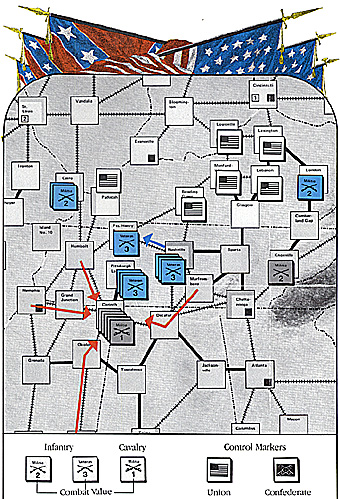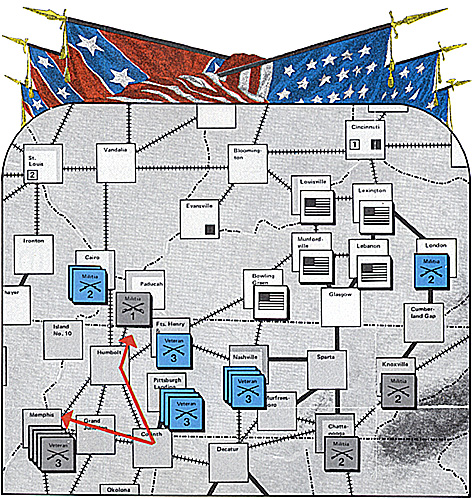
Sometimes it seems that the only way to get out of a bad predicament is to pick up the dice and risk battle, even at unfavorable odds. However the best defense may not necessarily be an offense-at least, not the obvious one. Here's an interesting strategy problem, solved by an unorthodox move. It's a problem familiar to many wargames, illustrated here in a simple, but sophisticated American Civil War game, A House Divided, published by Game Designers, Workshop.
STRATEGY PROBLEM
Spring, 1862. Positions shown on the map are the historical locations and strengths for the opposing Union and Confederate armies in the western Theater in March/April, 1862. Abbreviations: 2MI = two militia infantry units; 1VI = one veteran infantry unit; 1MC = one militia cavalry unit; etc.
Confederate recruiting cities: Memphis, Chattanooga, Atlanta, and (controlled by the Union)-Nashville, Cairo, Evansville, Bowling Green, Louisville, Cincinnati.
Union recruiting cities: St. Louis, Cincinnati, Cairo, Louisville, and (controlled by the Confederates)-Knoxville.
Grant (2VI, 1MI) moved to Pittsburgh (sic) Landing (Shiloh) after his victories at Forts Henry and Donelson-eliminating the Confederate 1MI there and earning a promotion for one Union militia unit to ,'veteran" status for the victory.
Buell (2VI, 2MI) maneuvered Hardee's Confederates (1VI, 1MI) out of Kentucky and captured Nashville without a fight.
Morgan's Union division (1MI) and Kirby Smith's Confederate command (1MI) sat guarding either side of the Cumberland Gap.
Pope's small Union army (IMI) began assembling just north of Island No. 10, preparing for an attack down the Mississippi River. Another IMI was recruited at Cairo at the end of the Union player's turn, joining Pope's 1MI already there.
A.S. Johnston reacted by concentrating all available Confederate forces at CorinthHardee (1VI, IMC) from Murfreesboro, Bragg (1MI) from southern Mississippi, Ruggles (1MI) from Memphis, and Polk (1V I) from Humbolt.
The Union player got a poor die roll for his next movement allowance. Buell shifted IVI from Nashville to Forts Henry and Donelson to reinforce Grant if he was attacked, or to return to Nashville if Buell was attacked in the Confederate player's next move. (Battles occur when opposing forces occupy the same box. After the first round of battle, you may add one unit from any adjacent box each round as reinforcements to continue the battle.)
The other Union moves available had to be used in the Eastern Theater around Washington, D.C. (not shown).
It's now the Confederate player's turn. He rolls a "1" for his movement allowance. There's one move that must be made to guard Richmond (not shown). What can be done this turn here in the Western Theater?
Several Confederate recruiting cities (which also help determine the maximum size of the Confederate army each turn) are threatened: Atlanta-Grant can move by river to Chattanooga as one "march;' then overland to Atlanta; Chattanoogaeither Buell or Grant can capture it; and Memphis-Pope can move to it by river from Cairo. The Union forces outnumber the Confederate forces in this theater 10 to 6.
Historical Result: Johnston moved directly against Grant, almost winning the Battle of Shiloh, the first major battle fought in the West during the Civil War. After initial Confederate success, Union reinforcements and Confederate lost momentum turned the tide and the Rebels were forced to retreat back to Corinth.
Worse than the defeat at Shiloh were the strategic consequences of the Confederate gamble-Memphis and Corinth were both captured by Union forces soon after the battle, and only Buell's lethargy (bad dice rolls!) kept Chattanooga from falling to the Union.
Can you change history? Disaster looms for the Confederate forces in the West. What's your move?
STRATEGY SOLUTION
Attacking Grant at Pittsburgh (sic) Landing is not a good move. In fact, attacking anywhere in the West this turn is not a good move for the Confederate player. However, getting into position to attack in the next turn is the best way to simultaneously protect Confederate recruiting cities and threaten Union control of Kentucky.
Even with a die roll of "1," each player is permitted two moves or "marches" per turn. Since one move had to be used to protect Richmond (not shown), that still left one move available in this theater.
The Confederate movement shown is counted as one march since all Confederate units started in the same box, even though they split up. Cavalry may move two boxes as one march and 1MC captured Paducah. Infantry may move two boxes by friendly railroad line as one march and 2VI 2MI at Corinth shifted to Memphis.
At the end of the turn new units are recruited and a Confederate 1MI at Chattanooga.
The Union player now faces a serious dilemma. The key problem is that troublesome Confederate cavalry unit at Paducah. It's Nathan Bedford Forrest, starting his career as a cavalry raider in this game a little sooner than actual history. "That Devil Forrest;' as Sherman would later call him, can move to Evansville or Louisville in one march next turn, and even reach Cincinnati in two marches.
Confederate control of any of these cities enables a Confederate 1MI to be recruited and placed on the one city controlled by the Confederate player on the next turn. This threat can't be ignored--a small group can swiftly swell into a major army, well behind the Union forces in Tennessee!
Forrest must be stopped now, but it's not easy to do it. Since all Union units are infantry type, a direct attack on Paducah will not work- the Confederate cavalry unit may simply withdraw to any unoccupied box, such as Evansville (!).
Moving a Union unit from Cairo to Evansville by railroad in two marches will not stop the Confederate cavalry unit either--it may "jump" over infantry units and go to the next box (Louisville).
A combination of moving a Union unit to Evansville and attacking Paducah will stop Forrest, although he may still withdraw to Humbolt and avoid battle. To do this requires the Union player's movement die roll to be at least "3." A die roll of "1" or "2" (33% chance) allows only two marchesinsufficient to stop Forrest.

Of course, a good Union movement die roll can eliminate the Confederate cavalry unit if another Union infantry unit moves into Humbolt and blocks the only route of retreat. The Confederate player is risking the loss of the cavalry unit by moving it to Paducah, but it is worth it.
Even with a high Union movement die roll of "5" or "6," it will take three marches to stop Forrest; four marches to eliminate him. On a die roll of "6" the Union player may invade a Confederate coastal city, and this rare opportunity can't he ignored. So, at best, the Union player has five marches to use in this theater assuming he doesn't need to make moves elsewhere.
After using three or four marches to stop Forrest, that leaves only one or two marches and Buell's command at Nashville for an advance. Grant's units at Pittsburgh (sic) Landing can reach Paducah in one march by river and would be used to attack Forrest.
If Buell moves from Nashville to Chattanooga in two marches, he will be attacking with a 3 to 1 advantage in units, but the Confederate defender has the river advantage (blue sides on the Chattanooga box). Also, Kirby Smith's 1MI at Knoxville can reinforce the Confederate 1MI at Chattanooga if it survives the first round of battle. A Union attack against Chattanooga only slightly favors the Union side.
Don't forget the Confederate army at Memphis. It's possible that a good recruitment die roll at the end of the Confederate player's turn will put 1MI at Chattanooga and 1MI at Memphis (not shown). This sizable force can attack Cairo in one march by river next turn. There's a good possibility the weakened Union forces at Cairo would be eliminated by such an attack before Grant's army (which moved to Paducah to attack Forrest) can reinforce the Cairo defenders, even if a Union 1MI is recruited and placed on Cairo at the end of the Union player's turn.
Confederate capture of Cairo would threaten St. Louis and other cities, and enable new Confederate units to be recruited in Cairo on the next turn. Should Buell move against Chattanooga and away from this threat? Grant will need help to counter-attack or block the expected Confederate offense next turn.
Note that only Pope's forces at Cairo and the Union IVI at Forts Henry and Donelson can reach Memphis this turn. Grant is three boxes away and infantry may only move two boxes along unfriendly railroad lines in one turn (Corinth and Grand junction).
Without attacking, the one Confederate move shown above protects Memphis and Atlanta from capture, and makes Chattanooga a difficult position to seize. More importantly, Union control of Kentucky is threatened, and, without heavy reinforcement by Grant's forces by river, Cairo may fall next turn to an attack from Memphis.
The potential disaster facing the Confederate player last turn has been turned into a potential gain next turn-without attacking (yet).
Summary: Sometimes it's better to look beyond the obvious move. Put yourself in your opponent's place and see what move(s) would be the most difficult to deal with.
Back to Table of Contents -- Game News #5
To Game News List of Issues
To MagWeb Master Magazine List
© Copyright 2000 by Dana Lombardy.
This article appears in MagWeb (Magazine Web) on the Internet World Wide Web.
Other military history articles and gaming articles are available at http://www.magweb.com